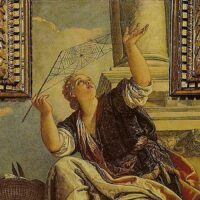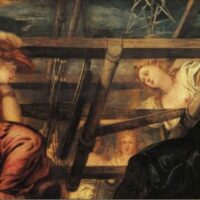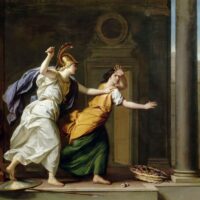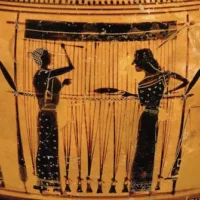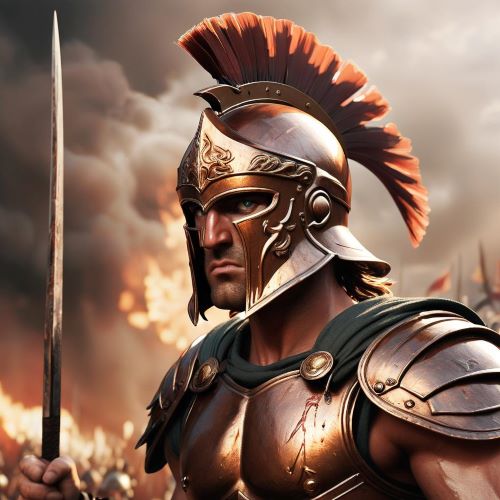Arachne : The Master Weaver
Listen
At a glance
| Description | |
|---|---|
| Origin | Mediterranean Mythology |
| Classification | Mortals |
| Family Members | Idmon (Father) |
| Region | Greece, Italy |
| Associated With | Weaving, Spiders |
Arachne
Introduction
Arachne is one of the most memorable figures in Greek and Roman mythology, a mortal whose skill and defiance placed her in direct conflict with the gods. Her story, most famously told by Ovid in Metamorphoses, explores the fine line between human genius and divine authority. Arachne was born a mortal woman of Lydia, celebrated for her weaving abilities, which became so renowned that people traveled from distant lands to see her work. Her talent, however, came with a dangerous flaw—an unwavering pride that led her to challenge the goddess Athena (Minerva in Roman tradition) to a contest of weaving. This bold act set in motion a chain of events that transformed her from a gifted woman into the first spider, destined to weave forever. The myth of Arachne is not only an origin story for spiders and their webs but also a timeless meditation on creativity, power, and the consequences of hubris.
Physical Traits
In ancient sources, Arachne is rarely described for her beauty or stature; instead, her defining features are the grace and dexterity of her hands. She is depicted as a young Lydian maiden whose focus and concentration made her weaving appear effortless. Ovid highlights the way her fingers worked wool with astonishing precision, producing cloth so fine and imagery so vivid that it seemed alive. Nymphs and mortals alike abandoned their tasks just to watch her at the loom, drawn not by her physical appearance but by the artistry of her craft.
Her transformation into a spider is central to the myth. When Athena struck her tapestry and Arachne, humiliated, tried to hang herself, the goddess intervened. Out of either pity or determination to immortalize her skill, Athena changed her into a spider. Ovid describes the process vividly: her body shrank, her limbs became thin legs, and her head grew small while retaining the ability to spin thread. From that moment, she was condemned—or blessed—to weave webs eternally. This metamorphosis made Arachne the archetype of the spider, linking her myth forever to the natural world.
Family
Though Arachne’s story focuses mainly on her personal talent and defiance, ancient texts provide glimpses into her background. She was the daughter of Idmon of Colophon, a craftsman skilled in the art of purple dyeing. Purple dye in antiquity was a symbol of wealth and power, suggesting that even though Arachne came from modest origins, her household was closely tied to the world of luxury textiles. Growing up in such an environment may have given her access to materials that helped refine her skill at the loom.
Some accounts expand on her family ties. Pliny the Elder records that Arachne had a son named Closter, whose name itself means “spindle.” He is credited in later traditions with introducing innovations in wool spinning. A rarer version of the myth mentions a brother named Phalanx, who, along with Arachne, was punished by Athena for an inappropriate relationship. These additional traditions, though less well-known, emphasize that Arachne’s lineage was linked to invention, skill, and the technical mastery of textiles.
Other names
The name Arachne is directly derived from the ancient Greek word Ἀράχνη (Arákhnē), which simply means “spider.” This etymological connection is at the heart of her myth, as her transformation gives rise to both the creature itself and the vocabulary surrounding it. From her name, modern biology draws the class Arachnida, which includes spiders, scorpions, and ticks. Similarly, the word “arachnophobia,” the fear of spiders, comes from the same root.
Unlike many mythological figures who collect a variety of epithets and alternate names, Arachne is remembered almost exclusively by this singular term. In Roman accounts, Athena appears as Minerva, yet Arachne’s own name remains unchanged. Her identity, therefore, is tied directly to her fate: she is the weaver who became the spider, her name forever synonymous with threads and webs.
Powers and Abilities
Unlike gods and heroes who wielded supernatural strength or divine weapons, Arachne’s power lay in her human artistry. Her weaving was so astonishing that onlookers believed no mortal could have achieved it without divine instruction. Yet Arachne herself claimed that her skill was entirely her own, not a gift from Athena. This bold claim led to the fateful contest with the goddess.
In their competition, Athena’s tapestry portrayed the glory of the Olympians, warning mortals against defying divine power. Arachne, on the other hand, wove scenes of the gods’ deceptions and transgressions, depicting Zeus’s many disguises and the ways in which gods often mistreated mortals. Technically, her work was flawless—so perfect that Athena herself could find no fault. But thematically, it was daring, for Arachne used her art to expose uncomfortable truths about divine behavior. Enraged, Athena destroyed the tapestry and struck Arachne, an act that led to her despair and eventual transformation.
After becoming a spider, Arachne retained her unique ability to spin, but in a new form. What had once been a mark of mortal pride became an eternal condition, making her both a symbol of artistic genius and the cautionary example of defiance.
Modern Day Influence
The myth of Arachne has had an extraordinary afterlife, resonating far beyond antiquity. In literature, she appears in Dante’s Inferno, where her pride serves as a warning to sinners, and in Edmund Spenser’s Muiopotmos, which retells her fate allegorically. Modern authors often reinterpret Arachne as a figure of resistance, reading her defiance against the gods as a feminist assertion of creative power against patriarchal control. Writers such as Margaret Atwood and other contemporary myth-makers revisit her tale to highlight themes of artistic freedom, censorship, and female voice.
In the visual arts, her story has inspired masterpieces across centuries. Diego Velázquez’s Las Hilanderas (The Spinners) presents a layered interpretation of her contest with Athena, while Rubens and other Baroque artists used the myth to explore the tension between beauty and punishment. Renaissance and later European artists frequently associated Arachne with the spider as a symbol of creativity and technical ingenuity.
Her legacy extends into science and language. The term “Arachnida” ensures that her name endures in biology, a direct reminder of the myth every time spiders, scorpions, or mites are classified. Medical terminology, too, reflects her legacy with the “arachnoid mater,” a web-like membrane in the human brain.
Popular culture frequently draws on Arachne’s symbolism. She appears in fantasy novels, anime, and video games, often reimagined as a spider-like sorceress or cunning trickster. These portrayals emphasize her dual identity: both victim and rebel, punished by the gods yet immortalized by her talent. Psychologists also use her myth as a metaphor for creativity, trauma, and the complex relationship between human striving and limits imposed by authority.
The enduring fascination with Arachne lies in her paradox. She is at once celebrated for her genius and condemned for her pride, a mortal whose brilliance challenged divine control. Her transformation into a spider captures both the tragedy and triumph of human creativity, ensuring that her story continues to be retold across literature, art, science, and digital culture. In every strand of silk spun by a spider today, the legacy of Arachne still lingers, a reminder of the risks and rewards of daring to rival the divine.
Related Images
Source
Centre of Excellence. (2023, November 7). The Story of Arachne in Greek Mythology – Powers, Symbols and Messages. Retrieved from https://www.centreofexcellence.com/arachne-in-greek-mythology/
Wikipedia contributors. (2025, September 11). Arachne. In Wikipedia. Retrieved from https://en.wikipedia.org/wiki/Arachne
Mythology.net. (2016, November 3). Arachne – Greek Talented Mortal Challenged Athena. Retrieved from https://mythology.net/greek/mortals/arachne/
Arachne. (2025, July 17). Britannica. Retrieved from https://www.britannica.com/topic/Arachne
Arachne (Arakhne) – Lydian Weaver of Greek Mythology. (2000, January 1). Theoi Project. Retrieved from https://www.theoi.com/Heroine/Arakhne.html
Arachne against the moderns anthropological approach of a politcal-religious conflict. (2010). Anales de Arqueología y Etnología, 21410. Retrieved from https://doi.org/10.5209/AMAL.21410
Arachne and Athena: Towards a Different Poetics of Women’s Writing. (2017). Retrieved from https://www.semanticscholar.org/paper/ac67ffd7a47c11584c592eb4a65f224a6d93dfcb
Arachne in Greek Mythology. (n.d.). Greek Legends and Myths. Retrieved from https://www.greeklegendsandmyths.com/arachne.html
Frequently Asked Questions
What is lorem Ipsum?
I am text block. Click edit button to change this text. Lorem ipsum dolor sit amet, consectetur adipiscing elit. Ut elit tellus, luctus nec ullamcorper mattis, pulvinar dapibus leo.
What is lorem Ipsum?
I am text block. Click edit button to change this text. Lorem ipsum dolor sit amet, consectetur adipiscing elit. Ut elit tellus, luctus nec ullamcorper mattis, pulvinar dapibus leo.
What is lorem Ipsum?
I am text block. Click edit button to change this text. Lorem ipsum dolor sit amet, consectetur adipiscing elit. Ut elit tellus, luctus nec ullamcorper mattis, pulvinar dapibus leo.
What is lorem Ipsum?
I am text block. Click edit button to change this text. Lorem ipsum dolor sit amet, consectetur adipiscing elit. Ut elit tellus, luctus nec ullamcorper mattis, pulvinar dapibus leo.
What is lorem Ipsum?
I am text block. Click edit button to change this text. Lorem ipsum dolor sit amet, consectetur adipiscing elit. Ut elit tellus, luctus nec ullamcorper mattis, pulvinar dapibus leo.



